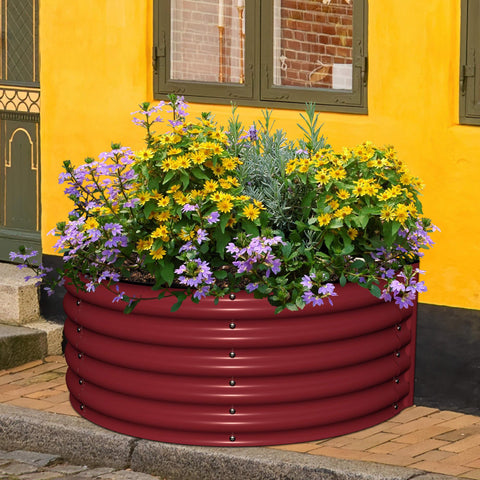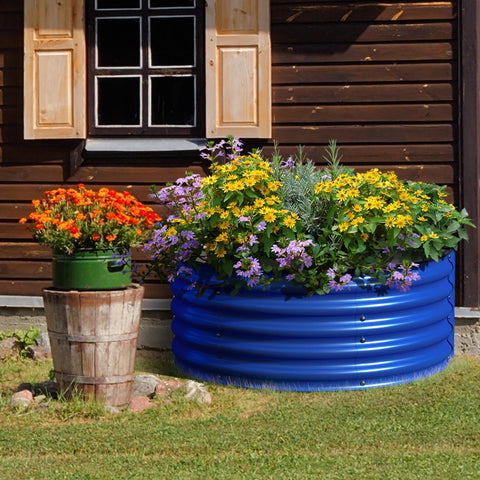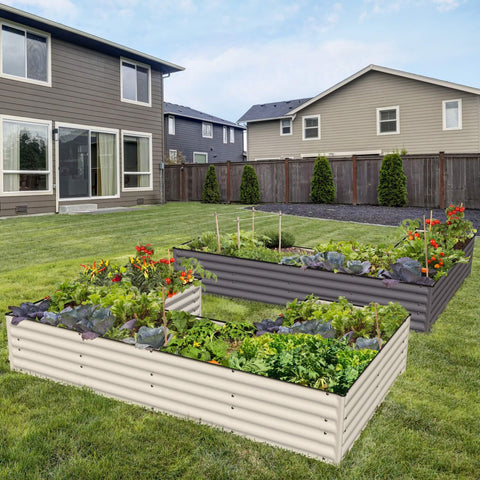How To Plant Flowers In A Raised Garden Bed
It's time to start planning your spring garden. Designing a garden is exciting, because the choice of flowers is almost endless! However, if this is your first time, a lot of information there may lead to a lot of problems: what kind of flowers should you plant? How do you plant flowers with seeds? When is the best time to plant them? What are the benefits of planting flowers in garden beds?

Before you start planting the garden, you need some tools.
Flowers or flower seeds
Soil
Soil tester and amendments
Garden plot, raised beds, or containers
Gardening fork, gloves, shears, and trowel
Step 1 - Know your location
Although it is easy to fall in love with bright colors or unique petals, you must first determine which flowers are suitable for your garden.
Different flowers need different amounts of sunlight, which should be marked on the seed bag and information label of the seeder. Some flowers like full sunlight (such as Egyptian starflower), partial sunlight/shadow (such as zebra) or full shade flowers (such as polka dots). Full-day plants need six or more hours of sunshine per day, part of the sunshine/shadow is about two to four hours, and completely shade for two hours or less.
To determine which flowers grow best in your location, please evaluate your gardening location. See where you plan to plant them and observe how much sunshine it has all day. Is the garden bathed in sunshine from dawn to dusk? Are there any trees that make it shady most of the day? Consider the amount of sunlight and pick flowers accordingly.
Step 2 – Assess your soil
Next, it's time to analyze your soil!
Analysis of soil helps to determine its ph (acid, neutral or alkaline), consistency (clay, loam or peat) and fertility. Many of these tests were completed in their own comfortable homes, and even DIY various household products!
Once you have a clear understanding of what your soil is like, find the flowers that thrive on your existing bed. Is your soil nutrient deficient, too dense, acidic or alkaline? Another option is to modify your garden to improve growth conditions. Improving soil means adding more organic nutrients, such as compost, dung and even wood ash, to improve ph, consistency and fertility.
Step 3 – Buy seeds or plants
Once you know which type of flower is most suitable for your garden lighting, it's time to shop!
There are numerous perennial and annual flowers, each with different colors, heights, widths and flowering times. Ways to get flowers include visiting gardening centers, checking seeds online or asking neighbors to breed their plants.
The local gardening center is beneficial because they have experts to guide you to choose the best flowers suitable for your local climate. On the other hand, online seed purchase provides unique flowers or varieties that are not common in local stores.
Another best choice is to ask neighbors, family or friends to breed their plants! A common form of reproduction is to cut down existing plants and put them into the garden to plant new plants. The advantage of this is that the factory has been proved to be successful! Your neighbor may even provide you with some nursing and planting skills!
Step 4 – Prepare the garden bed
Flowers will grow in different places: on the ground, on the raised garden bed, and even in containers. Planting in a raised garden bed has several advantages:
- Protect plants: elevated beds can protect plants from pets and children.
- Improve the visibility of plants: the elevated bed can make plants more easily observed, thus improving its decorative effect.
- Reduce ground humidity: elevated bed can reduce ground humidity, thus avoiding the death of some plants due to high ground humidity.
- Improve soil quality: elevated bed can prevent soil from being compacted, thus improving soil quality.
- Improve air circulation: elevated bed can improve air circulation, thus helping plant growth.

No matter which planting site you choose to plant flowers, it is important to prepare garden beds to promote optimal growth. To do this, you must first clean them up. Use a garden fork to lift the soil and turn it over. This will decompose the ground, loosen the soil, and release the remaining plants and roots.
Continue to prepare the bed by adding organic materials and gardening soil mixture. However, before purchasing the general flower soil mixture, it must be noted that different flowers need different soil consistency.
Some flowers like sandy mixture (such as Susan with black eyes), while others like moist and nutritious soil (such as Iris japonica). To find out which soil your flower is successful in, please check the seed package or search online.
Step 5 – Planting flowers
Whether you buy flower seeds or plants, the time you plant flowers is different.
The planting time depends on your cold-resistant area, ranging from 1 to 13. If you live in a warm climate (with a high number of regions), you can grow seeds or plants earlier in the year. However, those with colder climate (lower number of areas) must wait until April or May to plant.
No matter where you live, do not plant before the last frost. Once the risk of frost has passed, it's time to take out the gardening spatula and gloves and start planting! Don't want to wait so long? Plant seeds indoors. If necessary, use a growth lamp. Then, once the risk of frost has passed, put your seedlings in the ground!
If seeding, please use the spacing and depth on the package to guide you. For example, sow sunflowers are about 1 to 2 inches deep and about 6 inches apart. For those who plant established flowers, dig a hole with the same width and depth as your flowerpot. Gently remove the plant from the container and insert it into the ground to cover the soil at the bottom.
Once put into the soil, be sure to water the new plants well. Da! Your flowers have been planted and are ready to grow!
Step 6 – Protect your flowers
Now that you have planted the flowers, it is time to take care of them.
Regular watering
The best way to promote the growth of flowers is to water them regularly! Always keep in mind the type of flowers, the consistency of the soil and the amount of sunlight in the garden. However, as a general rule, a good way to determine whether to water is to insert your fingers into the soil. Is it wet? No need to water! Is the soil dry? It's time to give it some water!

Pruning and weeding
Dead branches are a gardening method to encourage your flowers to bloom again. To do this, use gardening scissors or fingertips to cut dead flower heads from plants.
It is also a good practice to regularly check the garden bed for weeds. Some weeds are invasive and spread quickly, so please remove them as soon as possible. Don't want to weed often? Use natural mulch on the garden bed to prevent weeds from spreading to the bed.
Start planting!
Use these steps to select the best flowers, plant them, and help them thrive.
Always remember to verify your current growth conditions and plant your flowers accordingly. When the flowers have proper sunshine, soil and care, they will reward you with bright flowers in the next few months
